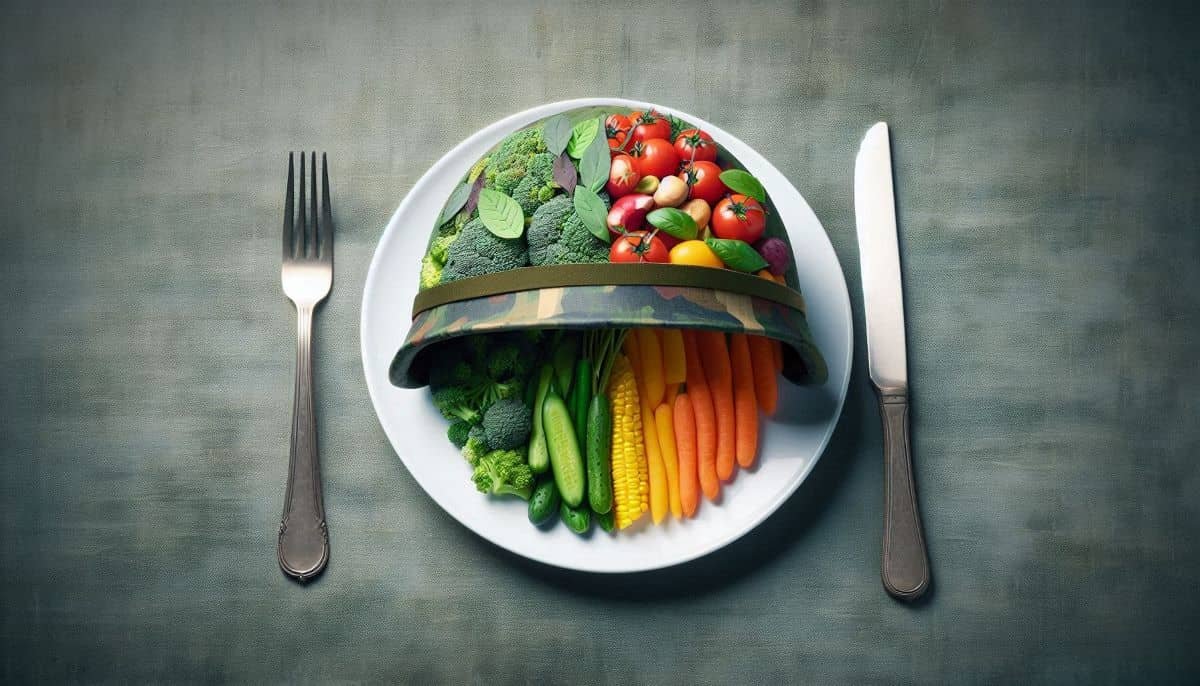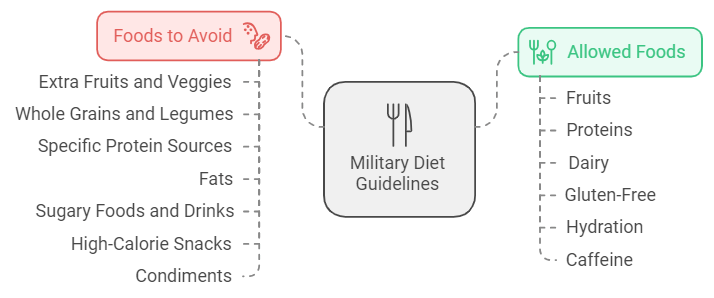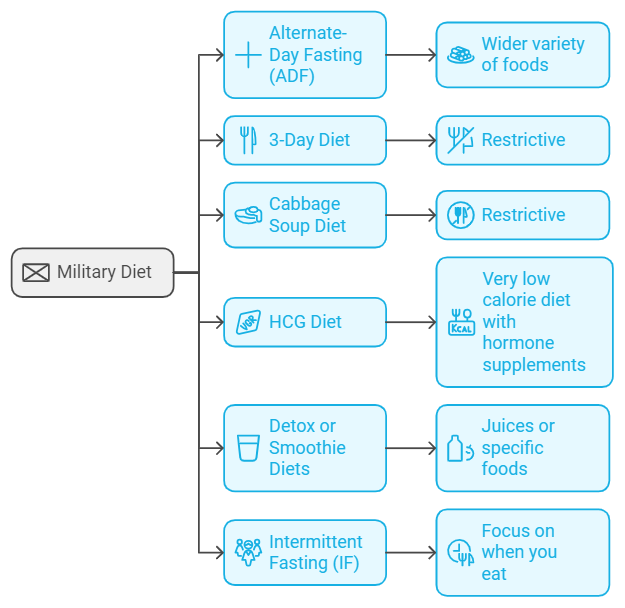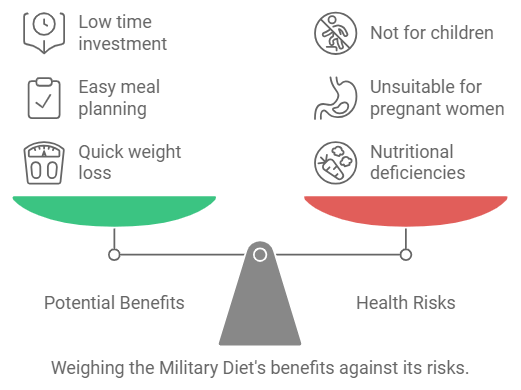The Military Diet: Is It Just About Calorie Restriction?
Everything You Need To Know About The Military Diet + Military Diet Meal Plan and Shopping List

In this post, you’ll learn about the Military Diet, a popular plan that claims to help you lose weight quickly without having to exercise a lot.
This diet is all about eating much less than usual, which might sound good but can have some downsides.
We’ll look into whether this diet is just a quick fix or if it actually teaches us something useful about managing our weight in a healthy way.
KEY TAKEAWAYS
- The Military Diet focuses on significant calorie reduction, with daily intake ranging from 1,000 to 1,400 calories.
- Weight loss on the diet primarily results from the drastic calorie deficit rather than specific food combinations.
- Scientific evidence supporting the diet’s unique food combinations for fat-burning is limited.
- Success on the Military Diet is more about adhering to strict calorie limits than the types of foods consumed.
- While calorie restriction is key, the diet’s structure and limited duration also contribute to its appeal for rapid weight loss goals.
What is the Military Diet, why is it called that way, and how does it work?
The Military Diet is a short-term eating plan designed to help you shed pounds quickly. You might wonder why it’s called the Military Diet. Well, despite its name, there’s no official military connection. It’s just a catchy title that suggests discipline.
The diet works by creating a calorie deficit, meaning you’ll eat fewer calories than your body needs, leading to weight loss.
For three days, you’ll consume low-calorie meals, including foods like toast, eggs, and fruits. This cycle of eating helps your body lose weight while still allowing some flexibility.
After these three days, you’ll have four days of regular eating, but it’s still recommended to keep your meals healthy. This diet isn’t about eating whatever you want; there are strict rules you need to follow.
3-Day Military Diet Meal Plan
To follow the military diet, you’ll need to plan your meals for three days. Each day has specific allowed foods, such as grapefruit, toast, and tuna, which you should include in your shopping list. You’ll also need to avoid certain foods, like sweets and fatty meats, during these three days.
Day 1: 1400 Kcal
Breakfast:
- ½ grapefruit
- 1 slice of whole-wheat toast
- 2 tablespoons of peanut butter
- 1 cup of black coffee or tea (caffeinated)
Lunch:
- ½ cup of tuna (canned in water)
- 1 slice of whole-wheat toast
- 1 cup of coffee or tea
Dinner:
- 3 ounces of any type of meat (preferably lean)
- 1 cup of green beans
- ½ banana
- 1 small apple
- 1 cup of vanilla ice cream
This mix might seem a bit odd, but it’s put together to keep you under 1,400 calories while still getting a variety of nutrients.
Day2: 1200 Kcal
On your second day of the Military Diet, you’re looking at a meal plan that’s a bit tighter, cutting down about 200 calories to hit around 1,200. Here’s your plan:
Breakfast:
- 1 egg (hard-boiled or cooked as desired)
- 1 slice of whole-wheat toast
- ½ banana
Lunch:
- 1 cup of cottage cheese
- 1 hard-boiled egg
- 5 saltine crackers
Dinner:
- 2 hot dogs (without buns)
- 1 cup of broccoli
- ½ cup of carrots
- ½ banana
- ½ cup of vanilla ice cream
Day 3: 1100 Kcal
As you approach Day 3 of the Military Diet, you’re hitting the home stretch. The calorie intake is a bit tighter, around 1,100, but it’s all about balancing nutrients. Let’s dive into what your day looks like:
Breakfast:
- 5 saltine crackers
- 1 slice of cheddar cheese
- 1 small apple
Lunch:
- 1 hard-boiled egg (or cooked as desired)
- 1 slice of whole-wheat toast
Dinner:
- 1 cup of tuna (canned in water)
- ½ banana
- 1 cup of vanilla ice cream
[DOWNLOAD THE MILITARY DIET MEAL PLAN AS PDF]
Military Diet Substitutions: Options for Vegans, Vegetarians, and Carnivores
When following the military diet, you can make substitutions based on your dietary preferences, whether you’re vegan, vegetarian, or carnivore. There are specific swaps for each diet type, as well as general substitutions that work for everyone.
Vegan & Vegetarian Substitutions
If you’re following a vegan lifestyle there are plenty of plant-based substitutions available, so you can easily modify the menu to suit your needs.
Let’s take a look at some options together.
- Meat: You can replace meat with lentils, beans, tofu, or portobello mushrooms.
- Dairy Products: Instead of cottage cheese, you can opt for vegan alternatives like tofu or non-dairy yogurt. And for cheddar cheese, nut-based cheese makes a great substitute. If you’re vegetarian swap it with Greek yogurt or ricotta cheese.
- Tuna and Eggs: You can use ½ cup of nuts or seeds, 1 cup of plant-based milk, or ½ cup of canned chickpeas or lentils.
With these substitutions, you won’t have to miss out on the benefits of the Military Diet while sticking to your vegan principles.
Carnivore Substitutions
On the other hand, you can adjust it to fit your carnivore preferences. Here’s what you can do:
- Meat: Go for lean cuts of chicken, turkey, or fish. These can replace hot dogs or other meats in the diet, helping you keep your protein high and your fat intake in check.
- Eggs: You can have eggs any way you like them. Think about adding a little extra protein on the side, maybe a couple of slices of bacon (just don’t go overboard).
- Dairy Products: Opt for full-fat dairy products. Regular cheese instead of low-fat versions can give you those extra calories and fat you need, without the fillers that come with processed low-fat options.
Here are some general swaps you can make across various diets:
- Banana: If for some reason you don’t like bananas or can’t get them, you can switch one banana out for 2 kiwis, 1 cup of papaya, or 2 apricots. These choices give you a similar nutritional punch and natural sweetness.
- Grapefruit: Grapefruit isn’t everyone’s cup of tea and some medications don’t mix well with it. If that’s the case for you, try oranges or other citrus fruits instead. They’ll give you a similar boost of vitamin C and fiber.
- Saltine Crackers and Bread: If you’re avoiding gluten or just want to stay away from processed grains, you can swap out saltine crackers for rice cakes and replace bread with corn tortillas or gluten-free varieties. This way, you can stick to your dietary needs without messing with the overall structure of the diet.
Foods That Are Allowed And Foods That Are Not

Allowed Foods on the Military Diet
Doing the Military Diet might seem tough at first, but once you get the hang of what foods are allowed, it gets easier.
This diet is all about quick weight loss and lasts for three days. You need to stick to the foods they tell you to eat, but don’t worry, there are some changes you can make if you need to.
For example:
- If you’re not a fan of grapefruit, you can switch it out for an orange, which helps keep your body’s pH levels in check.
- You can also swap out proteins, like having chickpeas instead of tuna or tofu dogs instead of hot dogs if you’re vegetarian.
- If cottage cheese isn’t your thing or if you’re vegan, you can go for Greek yogurt or tofu. And if you’re sensitive to gluten, you can choose gluten-free bread and crackers.
Drinking water is super important on this diet, so make sure you’re getting enough. If you need some caffeine, you can have black coffee or tea, just remember to skip the sugar and cream to stick to the diet.
Foods to Avoid on the Military Diet
When you start the Military Diet, there are some foods that you need to stay away from.
- First off, you’ll have to say no to any extra fruits and veggies that aren’t part of the diet plan. The same goes for whole grains and legumes. If it’s not on the list, it’s not on your plate.
- Thinking about adding more protein? Hold that thought. You’ll need to stick to the protein sources given in the diet and not go beyond that.
- And those added fats like butter or oils? They’re a no-no too.
- We all love a sweet treat, but sugary foods and drinks are off the table. You’ll need to stick to water, black coffee without any fancy additives, and tea.
- As for those high-calorie snacks, like chips and cookies, they’re out as well. And yes, alcohol is a big no.
- When it comes to condiments, most of them that contain calories, like ketchup or mayo, aren’t allowed. But don’t worry, you can still use stevia if you need a sweetener.
Now, I know you might be thinking, “What if I’ve dietary restrictions?” Well, you can make substitutions, but there’s a catch. They need to have the same calorie count as the original food item.
Military Diet Shopping List
Before you start the three-day Military Diet, it’s important to make sure you have everything you need.
I’ve prepared a shopping list for the Military Diet based on the required foods for the three-day meal plan. I got the prices from Amazon Fresh listings, but actual prices may vary based on your location and availability.
| Item | Quantity | Estimated Price (USD) |
|---|---|---|
| Grapefruit | 1 | $0.75 |
| Apples | 2 | $1.50 |
| Bananas | 2 | $0.50 |
| Whole Wheat Bread | 1 loaf | $2.50 |
| Peanut Butter | 16 oz | $3.00 |
| Eggs | 1 dozen | $2.50 |
| Canned Tuna | 3 cans | $4.50 |
| Hot Dogs | 1 package (8) | $3.00 |
| Lean Meat (e.g., Chicken) | 1 lb | $5.00 |
| Green Beans (fresh/frozen) | 1 lb | $2.00 |
| Broccoli | 1 small head | $1.00 |
| Carrots | 1 lb | $1.00 |
| Saltine Crackers | 1 box | $2.00 |
| Cottage Cheese | 16 oz | $2.50 |
| Cheddar Cheese | 8 oz | $2.50 |
| Vanilla Ice Cream | 1 pint | $3.00 |
| Coffee or Tea | 1 box (or bag) | $5.00 |
Total Estimated Cost
The total estimated cost for all the items on the list is about $36.75 for all three days. This includes essentials like whole wheat bread, peanut butter, eggs, tuna, coffee or tea.
Does the Military Diet Really Work?
The Military Diet has caught people’s interest because it claims you can lose weight really fast.
Some people, like Nikolina Skoric from GQ Australia, decided to give it a try, and here’s what happened. For three days, Nikolina followed a strict meal plan with low calories, high protein, and interesting food combos, like tuna with banana.
At first, she felt okay, but soon the hunger and dizziness kicked in, making her workouts tough. She did lost 2kg in just 3 days but struggled with energy and nutrition.
The diet was cheap and simple, but not sustainable. Nikolina wouldn’t try it again, fearing weight gain after stopping.
Another user, Jess DuPuy, shared her experience on her Hubpage blog about trying the Military Diet with her boyfriend.
They had gained some “relationship weight” and wanted a quick fix. The couple prepared by buying organic peanut butter and checking calorie counts.
Jess found the diet tough; she felt hungry and had to resist extra coffee. Her boyfriend struggled more, feeling lightheaded and irritable.
Despite the challenges, they managed to complete the three days with some teamwork and encouragement. Jess lost 4.5 pounds, and her boyfriend lost 7 pounds. She might try it again, but her boyfriend likely won’t. (4.5 pounds is equivalent to approximately 2.04 kilograms, and 7 pounds is about 3.18 kilograms).
Popular YouTuber Ashley Elliott also shared her experience in her YouTube channel about trying the Military Diet for three days.
Curious about its promise of quick weight loss, Ashley documented her meals and feelings throughout the challenge. Despite cravings and temptations, like her husband’s cookie baking, she stuck to the plan.
The diet consisted of limited calories and a mix of foods like peanut butter, tuna, and ice cream. Ashley found it tough but rewarding, losing 6 pounds by the end. While she wouldn’t recommend it long-term, she suggested it for quick results before special events (6 pounds is about 2.72 kilograms).
What Are the Benefits of the Military Diet?
Moving on from whether the Military Diet actually works, let’s talk about what it can do for you.
- Lose Weight Quickly: One of the best things about this diet is that it can help you lose weight quickly, which is perfect if you’re looking to drop a few pounds in a short amount of time.
- Simple Meal Plan: The meal plan is really simple, with foods that you can easily find at any grocery store, so you don’t have to worry about complicated recipes or hunting down special ingredients.
- Variety: Plus, there’s enough variety in what you eat that you won’t get bored, which makes it easier to stick to the plan without feeling like you’re missing out.
- Intermittent Fasting: Another good thing about the Military Diet is that it includes a kind of intermittent fasting, which can help your body burn fat more efficiently and give your metabolism a boost. Since the diet is high in protein, you’ll feel full for longer periods, so you won’t be as tempted to snack between meals.
- Quick: And because the diet only lasts for a short time, it’s not as daunting as some other diets that require a long-term commitment. Who knows, it might even inspire you to make healthier food choices in the long run.
Are There Any Risks with the Military Diet?
While the Military Diet promises quick weight loss, it’s important to know the potential risks that come with this highly restrictive eating plan.
- Mood swings: As with the examples of people who have tried the military diet, we saw that they feel irritable, hunger and weakness. This is due to the high calorie restriction.
- Yo-yo dieting: On top of that, the cycle of losing and regaining weight quickly, known as yo-yo dieting, can negatively affect your metabolism and body composition. The mental and emotional stress of restrictive eating might also lead to an unhealthy relationship with food, impacting your overall well-being.
- Processed foods: Plus, the inclusion of ultra processed foods (e.g. hot dogs) in the diet raises concerns about long-term health risks, like heart disease and certain cancers.
- Unsustainable: The Military Diet’s unsustainability and potential negative impact on physical performance make it less than ideal if you’re looking for lasting results and a healthy lifestyle.
Military Diet and Intermittent Fasting: How Do They Compare?
Although the Military Diet and intermittent fasting have some might seem like having similarities with each other, they’re quite different.
The Military Diet is very strict and doesn’t give you much food, making it hard to keep up with.
On the other hand, intermittent fasting lets you choose what you eat and can be easier to stick with over time. The Military Diet makes you eat a lot less, so you might lose weight quickly, but you could also miss out on important nutrients because it’s not a balanced way of eating.
With intermittent fasting, you get to eat a variety of foods during your eating times, which can lead to better overall nutrition.
If you’re thinking about your health in the long run, the Military Diet might be risky because it’s so extreme. You could end up losing muscle and feeling tired all the time.
But if you do intermittent fasting the right way, it might actually be good for your metabolism and help reduce inflammation in your body. Just make sure you’re getting all the nutrients you need when you do eat.
At the end of the day, both the Military Diet and intermittent fasting can help you lose weight, but intermittent fasting seems to be the more flexible and sustainable option if you want the freedom to make your own food choices.
Can You Exercise While on the Military Diet?
While the Military Diet itself is quite restrictive, light to moderate activities like walking are encouraged. However, always pay attention to your body’s signals and adjust or stop if you feel overly fatigued, as the low caloric intake may affect your energy levels.
Military Diet Workout Suggestions
- Walking: Try going for walks, about 30 minutes each day. It’s a nice way to burn some calories without using up all your energy.
- Yoga: Doing some light yoga or stretching is also great. It helps you stay flexible, keeps the stress down, and might even help with those snack cravings during the tougher parts of the diet.
- Squats, Lunges, Push-ups: You can also do exercises that use your own body weight, like squats, lunges, and push-ups. These are good for keeping your muscles strong and for giving your metabolism a little boost, without needing to lift heavy weights.
- Light weights and resistance bands: If you’re up for it, using light weights or resistance bands can help keep your muscles toned, even when you’re eating less.
And if you’re feeling up to it, doing short bursts of more intense exercise followed by some rest can help burn more calories, without having to exercise for a really long time. Just be careful with this one, because you mightn’t have as much energy while you’re on the diet.
Similar Diets to the Military Diet
Many people look for diets similar to the Military Diet, hoping to find something that fits better with their lifestyle or food preferences.

If you’re one of them, you might’ve come across options like Alternate-Day Fasting (ADF), the 3-Day Diet, and the Cabbage Soup Diet. These diets promise quick weight loss, but they vary in how much they restrict your food choices.
- For example, with ADF, you alternate between days of normal eating and days where you significantly cut down your calories (to about 500). This can be a bit more flexible than the Military Diet because it allows for a wider variety of foods.
- Then there’s the 3-Day Diet and the Cabbage Soup Diet, which, like the Military Diet, focus on eating specific low-calorie foods to lose weight quickly. However, these diets can be pretty restrictive, and you might find them hard to stick to for a long time.
- You may have also heard of more controversial diets, like the HCG Diet, which pairs a very low-calorie diet with hormone supplements. Or Detox or Smoothie Diets, which often involve drinking juices or eating certain foods to “cleanse” your body. Again, while these can lead to quick weight loss, they mightn’t be the best for your health and could lack the balance of nutrients your body needs.
- On the other hand, Intermittent Fasting (IF), such as the 16/8 method, focuses more on when you eat rather than what you eat. This approach might offer you more flexibility than the Military Diet and could help improve your metabolic health.
It’s all about finding what works best for you and your body.
Who Is the Military Diet Best For, and Who Should Avoid It?
So, who’s the Military Diet really good for?

If you’re looking to lose weight quickly, maybe for a special event coming up, or you just want a quick start to a healthier lifestyle, the Military Diet might catch your eye.
It’s pretty straightforward – it tells you exactly what to eat, which is great if you don’t want to spend a lot of time planning out your meals.
But, it’s not all sunshine and rainbows. This diet can be really restrictive, which means you mightn’t get all the nutrients your body needs. That’s why it’s not a good fit for everyone.
- If you’re pregnant, a child, or dealing with chronic health issues, you should steer clear. Also, if you’ve had issues with eating disorders in the past, this diet’s strict rules and low calorie count could bring up some unhealthy habits again.
- And if you’re really active or an athlete, you might find that you’re not getting enough energy from the food to keep up with your activities.
- Finally, if you have health problems like diabetes or heart disease, it’s really important to talk to a doctor before starting a diet like this. Losing weight too fast or not getting the right nutrients can be risky for your health.
Key Takeaway: Is It Just About Calorie Restriction?
At its core, the Military Diet is really about one main thing: cutting down on calories.
You’ll be eating around 1,000 to 1,400 calories a day, which is a lot less than what most adults usually have (an adult female needs around 2000 calories per day, while a male adults requires around 2500 per day). This drastic reduction is what mainly leads to losing weight quickly for many people.
But it’s not just about having less food; the diet also focuses on eating certain foods together, which some people believe helps burn fat more effectively. There isn’t a lot of scientific evidence to back this up, but eating fewer calories will definitely help you lose weight if you stick to it.
It’s important to remember that cutting calories this much can be hard to keep up with and mightn’t be good for you in the long run.
If you’re looking for quick results in a short time, the Military Diet might be something you want to try. But if you’re aiming for long-term health and fitness, you’ll need to find a more balanced and sustainable way to eat and live.
Check Also
